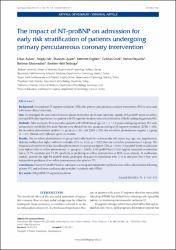The impact of NT-proBNP on admission for early risk stratification of patients undergoing primary percutaneous coronary intervention

Göster/
Erişim
info:eu-repo/semantics/openAccessTarih
2013Yazar
Ayhan, ErkanIşık, Turgay
Uyarel, Hüseyin
Ergelen, Mehmet
Çiçek, Gökhan
Özyurtlu, Ferhat
Ghannadian, Bahman
Tanboğa, İbrahim Halil
Üst veri
Tüm öğe kaydını gösterÖzet
Background: Incompleted ST segment resolution (STR) after primary percutaneous coronary intervention (PCI) is associated with worse clinical outcomes.
Aim: To investigate the association between plasma N-terminal pro B-type natriuretic peptide (NT-proBNP) levels on admission and STR after reperfusion, in a patient with ST-segment elevation myocardial infarction (STEMI) undergoing primary PCI.
Methods: After exclusion, 81 consecutive patients with STEMI (mean age: 61.3 +/- 13.4 years) undergoing primary PCI were prospectively enrolled in this study. Patients were divided into two groups according to ST-segment resolution: Sigma STR < 50%, the no-reflow phenomenon positive (+) group (n = 20), and Sigma STR >= 50%, the no-reflow phenomenon negative (-) group (n = 61). Patients were followed up for six months.
Results: The no-reflow phenomenon (+) group had similar baseline cardiovascular risk factors (e. g. age, sex, hypertension, diabetes mellitus) but higher mid-term mortality (25% vs. 6.5%, p = 0.02) than the no-reflow phenomenon (-) group. The frequency of anterior MI in the no-reflow phenomenon (+) group was higher (75%, p = 0.02). NT-proBNP levels on admission were higher in the no-reflow phenomenon (+) group (p = 0.001). A NT-proBNP level >= 563.4 pg/mL measured on admission had a 72.7% sensitivity and 72.9% specificity in predicting no-reflow phenomenon at ROC curve analysis. At multivariate analysis, anterior MI, high NT-proBNP levels, prolonged chest pain-to-reperfusion time (> 6 h) and post-TIMI-3 flow were independent predictors of no-reflow phenomenon after primary PCI.
Conclusions: Plasma NT-proBNP level on admission is a strong and independent predictor of no-reflow phenomenon following primary PCI and mid-term cardiovascular mortality in patients with STEMI.

















